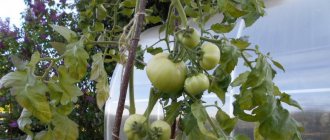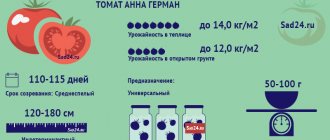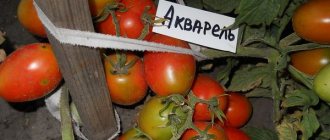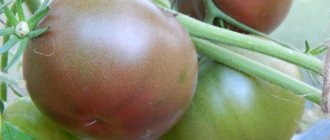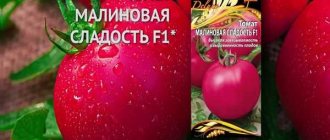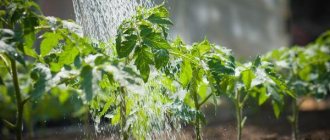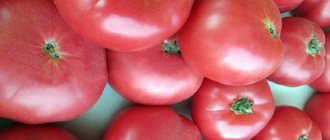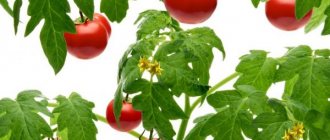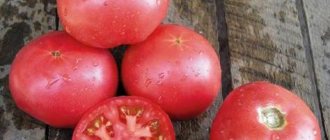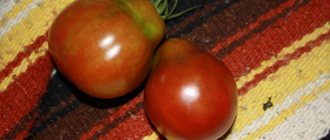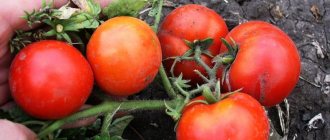The green color of tomatoes does not always indicate their immaturity. Breeders have developed varieties whose fruits retain a green tint even when ripe. These tomatoes not only have an unusual appearance, but also have an unusual taste. The fruit contains chlorophyll. It helps normalize metabolism, increase immunity, better saturate the body with oxygen and increase overall tone.
Most green-fruited tomatoes do not have high yields. They are demanding in care and often get sick. Tomato Irish liqueur does not have these disadvantages. What are the advantages of this variety and how to grow it on your site - read on.
General description of the variety
Irish liqueur is a varietal tomato. It appeared relatively recently on the markets of our country, but has already managed to win the love of gardeners. This tomato has not yet been included in the state register.
Advice . Since Irish Liquor is a variety and not a hybrid, the seeds from its fruits can be used for further planting.
The Distinctive Characteristics of Irish Liquor
The main distinguishing feature of Irish liqueur is the unusual color of its fruits. When ripe, the berries of this tomato variety acquire a green-yellow hue. Therefore, it is difficult for gardeners who grow it for the first time to determine the stage of ripeness of tomatoes.
Tomatoes of this variety are classified as large-fruited. On average, the weight of the fruit varies between 200-300 g. Larger specimens are also found.
The green color is due to the high content of chlorophyll in their composition. This substance has a positive effect on the state of the body, normalizing all processes in it. In addition, these tomatoes are less likely to cause allergies than their red-fruited counterparts.
The taste of green tomatoes is also unusual. The fruits of Irish liqueur are soft and juicy. They are sweet, with barely noticeable sourness and a pronounced fruity flavor.
Interesting . The Irish Liqueur tomato is often compared to another green-bearing tomato, the Malachite Box. Gardeners agree that the second option has a sweeter taste without sourness, but its fruits have a less neat shape.
Tomato bushes are tall. They need timely shaping and garter. Tomatoes of this variety rarely get sick. They are almost never affected by late blight.
Characteristics
The characteristics of Irish liqueur are not very different from other green-fruited varieties. Let's look at them in more detail in the table.
| Parameter | Indicators |
| Bush type | Tall indeterminate tomato. Its bush reaches a height of 1.5 m. The stem is thick and powerful, weakly leafy. There are few stepsons. The leaf blade is ordinary, medium in size, with slight pubescence. The color of the leaves is light green. The inflorescences are simple. The first is formed in the axil of the ninth leaf. The next ones appear every 2-3 leaves. The fruits are produced in clusters. From three to five berries are collected on one brush. |
| Growing method | A heat-loving variety that does not tolerate temperature fluctuations. In the northern and central regions it is grown in greenhouses and film shelters. In the south, cultivation in open ground is possible. |
| Productivity | Average. One bush produces up to 4 kg of tomatoes. According to gardeners, from 1 sq. m it is possible to collect up to 14 kg of tomatoes. |
| Fruit | Large ones. On average, the weight of one fruit varies between 200-300 g. The maximum weight of tomatoes of this variety is 600 g. The outside of the fruits is light green, with a yellowish tint. Covered with dark green stripes. The inside of the berries is light green, with a light spot in the center and dark green areas around the seed chambers. The shape of the berries is rounded and flattened. There is pronounced ribbing at the base. The fruits are juicy and soft, there is a lot of pulp. The taste is sweet with barely noticeable sourness and an unusual aftertaste. There are 6-7 chambers in each berry. Each of them contains a small number of small seeds. |
| Transportability | Low. Ripe fruits are soft. Easily damaged when pressed. They are stored for no more than two weeks. |
| Ripening time | Medium late. The fruits ripen 115-120 days after sowing the seeds. Fruiting continues until the first frost. |
| Disease resistance | There is immunity to tomato diseases. |
Note ! Irish liqueur is a new variety that is not included in the state register. Therefore, conclusions about its resistance to late blight and other tomato diseases were made on the basis of numerous reviews from gardeners who have already grown it.
Description
The plant is indeterminate, but not too tall, with a maximum height of about 1.5 meters. The bush is strong, but not spreading. Shoot formation and foliage are moderate. The leaves are of the usual type, slightly wrinkled, medium-sized, light green. The first fruit cluster is placed above the 8th - 9th leaf. Each brush has 3 - 5 ovaries.
The fruits are flat-round, slightly flattened at the top and base, slightly ribbed, with cheeks. The skin is dense, but not hard. An unripe tomato is rich green; a ripened one becomes a dull green color. The fact that the tomato is fully ripe will be indicated by the appearance of a yellowish tint and the presence of blurred stripes. The fruit becomes softer to the touch. The pulp has a delicate consistency, but is quite dense, juicy, and meaty. The taste is excellent, sweet, harmonious. The usual acid is absent, so green tomatoes can be consumed by people with gout and sore joints. There are 6 seed chambers, they are small, located closer to the walls of the fruit, and there are few seeds. Weight of tomatoes 200 - 400 grams.
Growing seedlings
Seedlings of exotic varieties are rarely found in markets. You will have to grow it yourself. Even a novice gardener can cope with this task, provided that the basic rules are followed.
Sowing of seeds begins in March. From the moment the first shoots appear until the tomatoes are planted in a permanent place, no more than 55 days should pass.
Seed preparation
Before use, the seeds must be treated with a number of preparations. This will help reduce the likelihood of plant infection, increase their resistance to negative external factors and accelerate the germination of planting material.
Before you start working with planting material, you need to check it for germination. To do this, the seeds are soaked for 30 minutes in salted water. Only those that have sunk to the bottom are considered suitable for planting. They are washed and dried.
To reduce the likelihood of tomatoes being infected, the seeds are treated with disinfectants. Usually at home they are soaked in the following compositions:
- in a light pink solution of potassium permanganate for 30 minutes;
- in hydrogen peroxide for 15 minutes;
- in a soda solution for 12 hours;
- in aloe juice for 12 hours;
- in “Fitosporin” for 6 hours.
Then the seeds are treated with growth stimulants. To do this, planting material is soaked in Epin, Sodium Humate, Zircon or honey water.
Some gardeners prefer to plant already sprouted seeds. To germinate planting material, it is wrapped in pieces of gauze soaked in warm water or a growth stimulant. The material with the seeds is placed in deep saucers, which are covered with film and placed in a warm place. It usually takes 3 days to germinate seeds this way.
Selection of containers and soil
Tomato seeds are often sown in one large container. To do this, use wooden boxes or plastic trays. Containers for sowing planting material are made from available materials. Disposable deep plates, packaging for meat products, semi-finished products and desserts are suitable.
Tomatoes are planted in separate containers. It is most convenient to use peat pots, from which you do not need to remove plants when transplanting them to a permanent location. Plastic pots, cut-off bottles and disposable cups are also suitable.
Advice . Typically, gardeners plant several bushes of green-fruited tomatoes on their site. In this case, it is advisable to use peat tablets for growing seedlings.
All containers must be disinfected before use. To do this, they are doused with boiling water or soaked for half an hour in a dark pink solution of potassium permanganate.
Soil for tomato seedlings can be purchased at the store or prepared independently. In any case, the soil is disinfected by watering with a strong solution of potassium permanganate, copper sulfate or boiling water.
To make your own soil mixture, you need to mix peat, black soil and humus in equal proportions. Sand and ash are added to the resulting composition.
Sowing planting material
Soil is poured into the seedling boxes. It is watered generously with warm, settled water. Grooves are made in the soil at a distance of 3 cm from each other, into which the seeds are then placed at intervals of 2 cm.
The grooves with seeds are covered with earth. The containers are covered with film and placed in a warm place. It doesn't have to be well lit.
If the seeds are sown in peat tablets, the technology will be slightly different. In this case, the peat blanks are soaked in boiling water until they are completely swollen. Then one seed is planted into the resulting bags. Tablets with seeds are placed in one large container, which is covered with film and put in a warm place.
Seedling care
Many novice gardeners are afraid to grow seedlings on their own, thinking that caring for them will take a lot of time. However, by following simple rules, it will not be difficult to get healthy and viable plants:
- Until the seeds germinate, the tomatoes are kept under film. This allows you to create the conditions of high humidity that tomatoes need at this stage. The soil is moistened as it dries from a spray bottle.
- After the first shoots appear, the boxes with seedlings are moved to a well-lit but cool place. The temperature in it should vary between 15-17 degrees.
- After a week, the boxes with seedlings are put back into the warmth. At this stage, tomatoes need sixteen hours of daylight. In spring, natural light is usually not enough. Gardeners recommend using fluorescent lamps.
- When the sprouted tomatoes are in a common box, they are watered with a pipette or syringe. This is done to ensure that the liquid does not get on the above-ground part of the plants.
- After the first true leaves appear on the seedlings, they are planted in individual containers. A layer of drainage is poured onto the bottom of the pots.
- Seedlings planted in separate pots are watered from a watering can. Water should also not fall on the ground part.
- Tomatoes are fed 3 times during their growing period. Use special fertilizers for seedlings, vermicompost or complex mineral fertilizers. The first time feeding is applied two weeks after picking the plants, the last time - 3 days before planting in a permanent place.
- 14 days before planting tomatoes in the ground, they begin to harden. To do this, the seedlings are taken outside. The first day for 30 minutes, the second for 1 hour, the third for 2 hours, etc.
Humidity, watering
High humidity levels have a negative effect on the plant. To optimize it, it is necessary to ventilate the greenhouse or install a ventilation system.
Water the plants at the roots so that water does not get on the leaves, stems, or fruits. It is best to use a drip irrigation system in a greenhouse. It helps to dose water to the roots of tomatoes without flooding them.
As you know, the success of growing tomatoes depends on the quality of the seedlings. The “Irish liqueur” variety is grown by seedlings.
The best time to sow seeds for seedlings is March. The exact sowing time is determined by the estimated date of planting the seedlings in the ground. If it is planned for the end of May, then you need to sow the seeds in mid-March. For sowing, high-quality seed material is selected, processed and sown in seedling boxes. At a temperature of 25 degrees, seedlings appear within a week. Once a week, plants are fed with complex fertilizers. After planting in the ground, the first fertilizing is carried out two weeks later. Complex fertilizer is also used for it. During the period of fruit formation, potassium fertilizer is applied. You should be careful with nitrogen-containing fertilizers, as the variety will increase green mass to the detriment of fruiting.
As the bush grows, it is tied to a trellis.
Agricultural technology
In the south of our country, tomatoes are planted in open ground in early May. At the same time, it is possible to plant seedlings in unheated greenhouses in the central regions. In northern Russia, tomatoes are planted in greenhouses at the end of May.
Before planting seedlings in a permanent place, they are watered and fed. This must be done 3 days before the procedure.
Planting seedlings in a permanent place
It is important to choose the right location for tomatoes. It should be well lit. Nightshade crops should not grow in tomato beds for the last three years.
In the fall, the selected area is dug up and cleared of weeds. Humus and dry lime are added to the soil. This makes it more fertile and reduces acidity.
In the spring, the beds are dug up again. All roots that have managed to form are removed. The soil is watered with a solution of chicken droppings and disinfected with copper sulfate.
The holes are dug in a checkerboard pattern. The distance between rows should be 60 cm, and between plants - 50-60 cm. Per 1 sq. m place no more than three plants.
A handful of ash or long-acting granular fertilizer is poured into each hole. The plant is placed there, forming its root system towards the center. The stem is buried by tearing off several lower leaves.
Each planted tomato is watered with warm water. At least 1 liter of liquid is consumed per plant. The next watering is possible in two weeks.
Tomato care
Tomato Irish liqueur must be tied up. Otherwise, its stems will simply break under the weight of the fruit. For gartering, a wooden support is used, to which the plant is attached with a synthetic thread.
Form tomatoes into 1 or 3 stems. The more stems left, the more abundant the harvest will be, but the smaller the fruit.
During the pinching process, not only unnecessary shoots are removed, but also lower and yellowed leaves. It is important to do this carefully so that the “wound” is not very large.
Plants need to be watered abundantly, but infrequently. For 1 tomato use 2-2.5 liters of water. This procedure is carried out early in the morning or at sunset.
After watering, it is important to loosen the soil. This will prevent the formation of an earthen crust and restore root air exchange. The procedure should also be carried out after precipitation.
Fertilizers are applied 3-4 times per season. Alternate organic and mineral compositions. You cannot use fresh manure for tomatoes; it will burn the roots of the plants.
Foliar feeding is used 2 times per season. It is recommended to use compounds with boron.
Useful tips
To get the maximum yield of Irish liqueur tomatoes, we advise you to consider a few tricks:
- If several waterings have been missed, you should not pour a large amount of liquid onto the plant at once. This is especially true during the fruiting period. The lack of moisture must be replenished in small portions in several stages. To optimize soil moisture, a drip irrigation system is used.
- Experienced gardeners often place a ring of a cut bottle in the hole around the roots of the plants. This design protects the tomatoes from mole crickets and ensures rapid flow of moisture to the roots.
- To help the tomatoes pollinate faster, the bushes are shaken daily.
- The leaves above the fruit are removed. This increases the speed of berry ripening.
- Tomatoes are planted once a week. No more than three shoots are removed in one procedure.
Diseases and pests
According to gardeners, Irish liqueur tomatoes are rarely affected by diseases. They do not suffer from late blight and other tomato diseases.
Disease prevention is the key to successful tomato growing. To prevent plant infection, you need to:
- Disinfect soil, soil and containers that come into contact with plants. Seeds should also be disinfected.
- Before planting tomatoes in the beds, you need to remove all plant debris.
- Follow the rules of watering and planting.
- Treat the bushes weekly with a solution of potassium permanganate, Bordeaux mixture, and copper sulfate.
- Spray the bushes with a soap solution and wormwood decoction to protect against pests. Large insects should be removed manually.
How to achieve your goal
The task of any gardener is to get a harvest of delicious tomatoes without loss. To do this, you must follow the recommendations of breeders:
- start making seedlings no later than the second ten days of March;
- soil temperature during sowing and before germination: from 20 to 25 ⁰С;
- feed young plants several times with seedling complexes;
- the temperature after germination should not exceed 18 ⁰C;
- place the seedlings on a bright, cool windowsill, illuminated for up to 18 hours;
- Tomatoes are transferred to an unheated greenhouse from May 25 to June 10 (after late spring frosts);
- planting according to the scheme: 3 plants/m²;
- add a mineral complex to the soil according to the manufacturer’s recommendation;
- mulching the beds with non-woven black material or rotted organic matter (compost, grass, straw);
- organize drip irrigation to optimize water consumption;
- regularly weed the bushes of the variety;
- ventilate the greenhouse (tomatoes are not afraid of drafts);
- prevent air from overheating (on hot days, throw on white non-woven material);
- form into 2-3 stems;
- stepchild every week;
- remove leaves over ripe fruits;
- when growing, tie up stems and brushes;
- feed with complex mineral fertilizers;
- remove brown fruits.
See also
Description of the Maiden's Hearts tomato, characteristics and cultivation of the varietyRead
Some gardeners are keen on adding nitrogen to the soil before planting. With this attitude, Irish liqueur fattens and does not set fruit.
Harvesting and application
At the beginning of August, the first ripe fruits are harvested. They are collected individually, since this variety does not differ in its ripening speed.
The ripeness of tomatoes can be judged by the yellow-green color of the berries. They will be soft to the touch.
Irish liqueur is a salad variety. Its fruits are also used to prepare juices and sauces of unusual shades. Red and yellow tomatoes covered in green tomato sauce look very original.
Characteristics
- Irish liqueur belongs to the mid-early varieties. Ripening begins 115 days after emergence. The first harvest in the greenhouse, under favorable conditions, ripens in early July. Fruiting lasts until the onset of cold weather;
- the yield is average, which is noted in many sources and confirmed by vegetable growers. With good agricultural technology, 4.5 kg of fruits are harvested from 1 square meter. True, there are other facts indicating that more than 80 tomatoes have ripened on one bush, and if you take the minimum weight of 200 grams, the result will be impressive. But this is most likely an exception to the rule;
- in extreme heat there may be a break in fruit formation;
- There is no specific information about immunity. According to reviews, the plant is resistant to many diseases, but may suffer from late blight;
- fruits are not subject to cracking;
- Irish liqueur is no different in transportability; during long-term transportation, dents may appear in the fruit. The keeping quality of the variety is low; during storage the pulp softens;
- method of consumption: salad. You can, of course, process the harvest; the juice and paste will taste excellent. But the color, as they say, is not for everyone.
Farmer reviews
Feedback from farmers about the Irish Liquor tomato is positive. Many gardeners believe that it is even better than the Malachite Box.
Irina, Zelenograd: “I planted the Irish Liquor tomato for the first time this year. I liked the result. I planted only 4 bushes, from which I collected 2 buckets of fruit. The largest tomato weighed 400 g. I collected seeds from the first fruits for the next planting. I separated the pulp from the seeds using a sieve. I washed it, dried it and placed it in fabric bags.”
Gennady, Krasnodar: “I’ve been planting Irish liqueur for the second year now. In my experience, it grows better in greenhouses. I did not suffer from late blight or rot. I liked the taste. The color is really green, just like in the photo.”
General information about the variety
The plant reliably bears fruit in greenhouse conditions and in open ground. Description and characteristics of the variety:
- mid-early, maximum variety of tomato ripening up to 124 days;
- indeterminate;
- high yield, up to 12.7 kg of berries per 1 sq. meters in greenhouse conditions;
- medium height, maximum height 70 cm;
- simple inflorescence;
- average foliage of the bush;
- the first inflorescence is formed after the 9th leaf;
- high resistance to major diseases of the nightshade family;
- heat resistance;
- good berry set;
- maximum shelf life 12 days;
- unpretentious, able to bear fruit in poor soil conditions.
The tomato is suitable for cultivation in different climatic zones. A distinctive feature of the variety is resistance to extreme conditions. In addition to Russia, it is successfully cultivated by Moldovan and Ukrainian gardeners.
Fruit characteristics:
- flat-round or round shape;
- high density;
- slightly ribbed;
- glossy;
- ripe berries acquire a red color;
- large, maximum weight of ripe berries is 270 grams;
- fleshy;
- sweet;
- fragrant.
Hybrid tomatoes are suitable for canning, making pastes, purees and juices. The berry will be an excellent addition to a vegetable salad.
Tomato seeds “Irish liqueur” Seed House, mid-early, 15 pcs.
- Are common
- Trademark Sortsemovosch
- Article 4175834
- Certificate Not subject to certification
- Country of origin: Russia
- Composition of Seeds
- Packaging
- 400 pcs in box
- Packaging 10 pcs.
- Individual packaging No packaging
- Package size 15 cm × 8 cm × 0.2 cm
- Dimensions and weight
- Size 15 cm × 8 cm × 0.3 cm
- Gross weight 0.15 g
- Peculiarities
- Growing season, days 120
- Ripening time Average
- Sowing seedlings February - March
- Packaging Colored
- Features of cultivation Open ground
- Variety or hybrid Variety
READ MORE: How a rooster fertilizes a hen, mating diagram and description of the reproduction process
Even in a small garden you can get a bountiful harvest of vitamin-rich vegetables. Bright, tasty and fleshy fruits grow only from high-quality seeds. Modern science has learned to breed varieties that grow in the most infertile soil and require minimal care.
Tomato seeds “Irish Liqueur” Seed House, mid-early, 15 pcs, sprout quickly and en masse, without causing any problems to the gardener. An unpretentious plant produces a beautiful fruit, which is distinguished by a high content of valuable microelements and exhibits excellent taste in both culinary dishes and home canned food.
The variety, bred by experienced breeders, is resistant to common diseases and is not afraid of cold and drought. It actively grows and bears fruit in low light conditions.
Tips for Growing Vegetables
- Choose quality seeds from trusted manufacturers. You can save on planting material, but you need to do it wisely.
- Vegetables bear fruit abundantly only on suitable soil. For example, cabbage may die next to tomatoes, but be healthy next to mint or thyme.
- Seedlings will be very lethargic if grown in the wrong container. A container that is too large or cramped, poorly drained, or simply of poor quality will kill or spoil the sprouts.
- Don't forget to prepare the seeds for planting. Often, pre-sowing treatment not only promotes proper germination, but also saves the entire garden from infections that may contain seeds.
- Another common mistake is failure to comply with the timing of sowing and planting seedlings, which affect the plant’s ability to take root and develop. You can use the lunar calendar or information about agricultural technology that the manufacturer indicates on the packaging.
Sima-land has the right to independently and without notifying users select questions for publication. We do not post questions that:
- do not relate to the subject of the store’s operation or making purchases in it;
- contain profanity, offensive statements;
- contain links to other websites.
We do not publish questions that contain:
- links to other websites, as well as references to specific sellers and importers of goods;
- statements discrediting the honor, dignity and business reputation of third parties (including stores, manufacturers and importers of goods);
- materials (including in the form of text, video, graphic images, code) that violate the rights of third parties, including rights to results of intellectual activity and means of individualization.
Sima-land reserves the right to delete a published question at any time, as well as independently determine the period during which questions are considered relevant and for which they are published within the Sima-land website.
We do not undertake any obligation to inform users of the reasons for rejecting questions or deleting previously posted questions.
If a user asks a question, he agrees to receive notifications from the Sima-land website about new answers to his questions.
Sima-land has the right to independently and without notifying users select reviews for publication. We do not post reviews that:
- do not relate to the subject of the store’s operation or making purchases in it;
- do not relate to actual experience of using this product;
- do not contain useful information for other users;
- contain profanity, offensive statements;
- contain links to other websites.
READ MORE: Tomato sweet girl description and characteristics of the variety yield
We do not publish selections and reviews of products that contain:
- links to other websites in the text of the selection and review, as well as mentions of specific sellers and importers of goods;
- statements discrediting the honor, dignity and business reputation of third parties (including stores, manufacturers and importers of goods);
- materials (including in the form of text, video, graphic images, code) that violate the rights of third parties, including rights to results of intellectual activity and means of individualization.
Sima-land reserves the right to delete a published review, selection and review of products at any time, as well as independently determine the period during which reviews are considered relevant and for which they are published within the Sima-land website.
We do not undertake any obligation to inform users of the reasons for rejecting publication or deleting previously published reviews, ratings, selections and product reviews.
Description of tomato Irish liqueur
The Irish Liquor tomato is a collectible variety. Large agricultural companies in Russia, unfortunately, produce seeds of this variety in small quantities. Today, at TomatoTomatoes, we have for sale the seeds of this tomato from private collectors or from Sortsemovosch.
It has an unusually sweet taste! An original mid-early (115-125 days from germination) variety for growing in greenhouses. The plant is indeterminate and powerful. The first inflorescence is above the 8-9th leaf, there are 3-5 fruits in the cluster. The fruits are large (200-250 g), leveled, round-flat, fleshy, sugar. The color of the fruit is dull green, turning into yellow-green with barely noticeable stripes as it ripens.
We suggest you familiarize yourself with How to prune roses in the fall: timing, pruning rules, pros and cons
Tomato Liqueur: description and characteristics of the variety
Hybrid Liquor (red, orange) was bred for cultivation in areas with any climatic conditions. Suitable for regions with short and cold summers. In the south it can be grown in open ground conditions. In other areas, with a less favorable climate, in greenhouses.
Photo of tomato Liqueur F1
The hybrid belongs to early ripening tomatoes. The height of an adult bush reaches 170 cm. In this regard, the plant is formed during the growth process by pinching and pinching.
Fruit
The Liquor tomato fruits are small in size and all, as if chosen, are the same size. The weight of one fruit is 50 grams. The diameter is 5 cm. The walls are quite thick, from 8 to 10 mm. Despite the thick peel, it is easy to chew. It tastes sweet.
Interesting! The series to which the Liqueur hybrid belongs is called “Tomato-Fruit” - for its wonderful taste characteristics and the sweetness of the fruit.
Due to their uniform, compact size, tomatoes are ideal for whole-fruit canning. Preparations with a combination of red and orange fruits look especially beautiful.
Tomatoes are delicious in their raw, fresh form. Can be eaten separately or added as an ingredient to salads.
